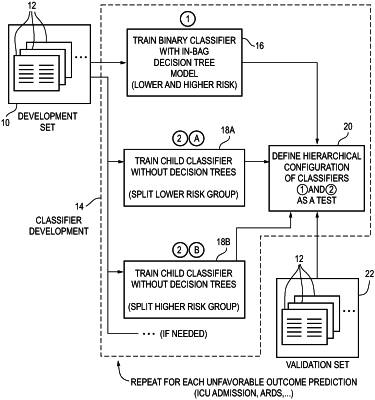| CPC G16H 50/30 (2018.01) [G06N 20/00 (2019.01); G16H 10/60 (2018.01); G16H 15/00 (2018.01); G16H 40/20 (2018.01); G16H 50/20 (2018.01)] | 7 Claims |

|
1. A method for predicting an unfavorable outcome for a hospitalized patient, comprising the steps of:
a) obtaining attributes from a health record for the patient comprising at least findings obtained at admission, basic patient characteristics and laboratory data,
b) iteratively training each of a set of initial binary classifiers from a development set and child classifiers from development subsets comprising data obtained from records for a set of hospitalized patients, including at least findings obtained at admission, basic patient characteristics, and laboratory data for each of such patient;
c) supplying the attributes obtained in step a) to a classifier using the trained set of initial binary and child classifiers implemented in a programmed computer trained to predict a risk of the unfavorable outcome, wherein:
1) the classifier is arranged as a hierarchical combination of (a) the initial binary classifier stratifying the patient into either a high risk group or a low risk group, and (b) the child classifiers further classifying the patient in a lowest risk group or a highest risk group depending how the initial binary classifier stratified the patient as either a member of the high risk or low risk group,
2) the initial binary classifier is configured as a combination of a trained classification decision tree and a logistical combination of atomic classifiers with drop-out regularization; and
3) the child classifiers are configured as a logistical combination of atomic classifiers with drop-out regularization; and
generating an output specifying a predicted risk of the unfavorable outcome for the patient based on a risk group in which the patient is classified.
|